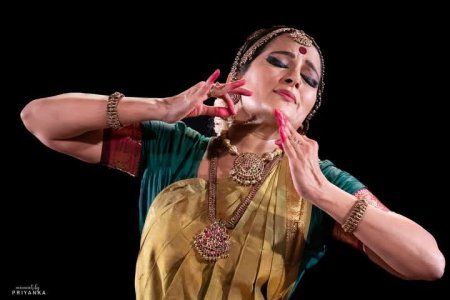
|   |

|   |
The vibrant, versatile Vidhya Subramanian - AM Hari Shankar e-mail: hshankar252@gmail.com Photo: Priyanka B January 10, 2025 The fluidity of Bharatanatyam has made a strong mark in the global artscapes due to the consistent cumulative effort of traditional practitioners and experimentalists. Dancer Vidhya Subramanian is a top-notch name in this galaxy of dancers. Known for her subtle, sensitive abhinaya, varied non-conventional themes, limiting choreographies from stereotypic format without deviating from the traditional aesthetics of her dance, she made a well-appreciated presentation in this year's Soorya, which stood unique for its multi-aspects. The initial "Agajanana padmarkaṃ... ... ekadantam upasmahe," a slokam praising Lord Ganesha was a fine commencement of the concert. Vidhya launched with a jathi followed by a captivating Devi composition of Balamuralikrishna in Lavangi ragam, praising the goddess as the one vanquishing our ego and containing herself within, the ashtamatrikas - Brahmani, Vaishnavi, Maheshvari, Indrani, Kaumari, Varahi, Chamunda and Narasimhi, each represented diligently by the dancer as the embodiment of Humkaara, the destructive and Hreemkara, the creative mantras maintaining the balance in the cosmos.  The following Sanskrit varnam "Satura Kamini" of Maharaja Swati Thirunal was set in Kalyani ragam and adi talam where the Sakhi as a mediator conveys her friend's plight to Lord Padmanabha. Her increased yearning for him has become intolerable that when she hears his conch, she is in a dilemma of emotions of happiness and jealous of the conch for being in closest proximity to the Lord's charming lips. Vidhya's poised expressions were felicitous with a natural fervor. The shifts from chathurasram to tisra gati before jathis were executed swiftly. The sollu rendition by the Nattuvanar was quite impressive and one could perceive his delight in the precise execution of jathis by the dancer. Violin rendition was in absolute blend with the depicted romantic segments. In "Harina mandala lasibaala desha", Padmanabha has been compared to a mad elephant's gait adorned with Kasthuri thilakam (musk) on his forehead. All the theermanams had a tisra gati layout and then back to chaturasra gati. Chitta swaram execution had an exceptional nritta and nritya facets. The increasingly paced rhythms with chiseled suddha nritta were interesting. Though Varnam is reasoned as the central piece of a Bharatanatyam performance due to its multitudinous perspectives of dance, the audience was highly impacted by the emotive portrayal of "Sakhi hey", the ashtapadi of 12th century poet Jayadeva's Geeta Govindam, set in Shuddha Saveri, mishra chapu. Radha, while in the arbor, recounts her first moment of lovemaking with Krishna to her sakhi and her yearning for him once again. Vidhya appeared on stage in a reclined position with a befitting light arrangement which was very pivotal in taking the audience to that eternal midnight. The beautiful depiction of heading towards a house in bowers filled with creepers ("Nibhritha nikunjja griham") quietly without making noise in the middle of the dark misty night, surrounded by the creatures of the night, she was chagrined to find Krishna smiling at her discomfort. The detailed comprehension of the contextual and allied intricacies instilled a profound impact on the connoisseurs. "Prathama samagama lajjitaya paṭ ucaṭ usatair anukulam" - The first moment, she was overwhelmed with shyness but his sweet words made her forget about herself, not even to realize his pulling away her garment. The sensuous articulations by Vidhya were deeply ethereal that one could feel the presence of Krishna on stage. "Kisalaya sayana nivesita ya... chumbanaya parirabhya krutadhara panam" - The flower bed intimate scene was illustrated as a real portrait as if two individuals were there on stage, showing the inimitable excellency of her abhinaya. The meticulously balanced presentation of this erotic, yet intense episode impacted the rasikas in its purest aesthetics. The vocalist Janani Hamsini and light designer of Soorya Ganesham need a special applause for creating such a spectral ambiance by her vocal improvisations and his lighting skills. The ashtapadi was followed with transcendental shift of character from a romantic Radha to a seductress woman figure in a choreography titled 'Shoorpanakha - the one with long nails', referred as Ati ghora, had her actual name as Meenakshi, the one with large eyes. This item takes a sneak peek into the episodes of Ramayana where she approaches Rama and Lakshmana and get snubbed and her nose cut off. It is an attempt to question society's standards about beauty and a woman's perception about herself. It also addresses the stigma associated with female desires and how it is expressed and conceived. The khanda gati mridangam beats elicited a demoness' entry aptly and on-stage the dancer loudly proclaiming her name to be Meenakshi, reflected the agony of her being called Shoorpanakha by the vocalist. With a stretch of violin rendition and mridangam rhythms to evocate the episodes and certain pauses on seeing Rama, this piece showcased the marvel of the instrumentalists. Vidya concluded with Adi Shankaracharya's Rajarajeshwari ashtaka thillana set to music by Rajkumar Bharathi in ragamalika, talamalika as a perfect finale encompassing multiple dimensions of the Mother Goddess cult with beautifully knitted jathis, and strong rhythmic cadences. The dancer's command on the nritta execution had an exemplary blend to acknowledge that thillanas are the ultimate joyous celebration segment for a dancer and a dance enthusiast. The excellent accompanying support had Vijayakumar on nattuvangam, vocal by Janani Hamsini Narasimhan, Kiran Pai on mridangam and Udupi Sreejith on violin.  A M Hari Shankar, an art enthusiast, percussionist and a connoisseur of Indian classical Arts is a Biologist-Educationist by profession, based in Delhi. Recipient of the Ministry of Culture Scholarship, his areas of interest include Life Science, Indian Arts and Spirituality. Some of his articles have been published in leading journals and newspapers. |